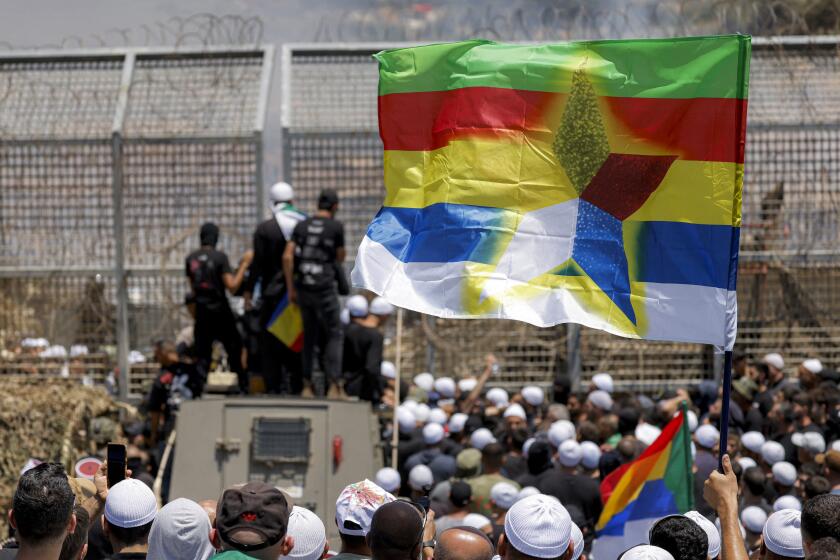Israeli warplanes pounded Syrian government buildings in the capital of Damascus on Wednesday, escalating its monthslong campaign against Syria’s new authorities amid heavy clashes between government forces and the country’s Druze minority.
The roar of jet engines reverberated around Damascus’ downtown districts as Israeli drones and warplanes peppered the Syrian military’s General Staff headquarters in the capital with missiles, engulfing sections of the compound in multiple fireballs. Bombs also were dropped near the presidential palace.
The bombing of Damascus comes as Israel continues to wage a multi-front war against most of its neighbors just weeks after it launched a campaign against Iran in hopes of destroying its nuclear capabilities. On Wednesday, even as it continued fighting in Syria, it launched attacks in Lebanon on what it said were assets for the Iran-backed Lebanese militant group Hezbollah, even while pressing its campaign against Hamas in the Gaza Strip.
Israel has hewed to a zero-threat-tolerance policy with the government of Syria’s interim President Ahmad al-Sharaa, a former Al Qaeda-affiliated rebel leader — he split from the group years ago — who was designated a terrorist by the U.S. until earlier this year.
Israeli forces gather at the border dividing the Israeli-annexed Golan Heights and Syria, while members of Syria’s Druze community gather on the other side. The Israeli troops sought to control crowds and prevent Druze from crossing the border with Syria. (Jalaa Marey / AFP)
In the hours after Assad fell, Israeli troops occupied a swath of territory along the border with Syria stretching toward neighboring Daraa province, adding to land Israel already annexed in the Golan Heights in 1981. (The occupation is considered illegal by international law.) At the same time, the Israeli military launched an all-out air campaign to destroy Assad-era materiel it feared could be used against it in a future conflict.
Since then, Israel has barreled its way into Syria’s complicated sectarian dynamics, vowing to defend the country’s Druze minority from the Islamist-dominated government: Over the last few months, it repeatedly hit Syrian security forces moving to subdue Druze-dominated areas; critics say it has used recent sectarian unrest as a justification to destabilize a once-troublesome neighbor.
The Druze, members of a religious sect that is an offshoot of Ismailism, number around 1 million people across the world, half of them in Syria. Most of the others are spread between Lebanon and Israel.
During Syria’s 14-year civil war, the Druze, wary of jihadi groups dominating the anti-Assad opposition, formed militias that fought the rebels but maintained a wary distance from Assad’s government as well.
Though many Druze were pleased to see Assad toppled, they — like other minorities in the country— remain fearful of the government’s jihadist origins. Recent sectarian unrest — such as in March, when government-linked factions massacred some 1,500 people, mostly from the Alawite sect — have only increased their suspicion. Then in May, other clashes in Druze-majority areas near Damascus left 39 people dead
Druze community leaders have resisted calls to have their militias stand down, insisting they will not surrender arms until government-affiliated factions disband.

Members of the Druze community demonstrate Wednesday before Israeli forces by the barbed-wire fence separating the Israeli-annexed Golan Heights and Syria. Israeli troops sought to control crowds and prevent Druze from crossing the border with Syria. (Jalaa Marey / AFP)
Fighting began on Sunday, when an intensifying wave of tit-for-tat kidnappings and robberies between Bedouin tribes and Druze militias near Sweida devolved into open conflict. As casualties mounted, the government announced a ceasefire agreement brokered with Sweida’s Druze leaders and dispatched its forces to secure the city.
But fighting soon restarted, with a Druze leader accusing security forces of indiscriminate shelling, while the government on Wednesday said that “outlaw groups” fired on Druze personnel and that the militia reserved its right to respond.
Later on Wednesday, a Druze religious leader, Sheikh Yusef Al-Jarboo, announced another ceasefire agreement with the government that would end all fighting in Sweida. But it was rejected by another Druze notable, who urged his co-religionists to continue fighting.
“There is no agreement, negotiation or mandate with the armed gangs that falsely call themselves the government,” said Sheikh Hikmat Hajari, a figure long opposed to the new authorities.
The Syrian Observatory for Human Rights, a Britain-based monitor with a network of activists in Syria, said 248 people have been killed in the violence since Sunday, including 21 people — three of them women — killed in field executions by government forces.
Activists spoke of additional infractions, publishing videos depicting government-affiliated gunmen forcibly shaving the mustaches of captured Druze fighters and harassing Druze civilians. Another clip depicts sword-toting government fighters entering Sweida and vowing to slaughter Druze. Druze fighters also uploaded videos to social media showing them beating up security personnel or posing with their corpses.

Members of Syria’s Druze community walk through tear gas fumes released by Israeli forces on Wednesday to disperse them at the barbed-wire fence dividing Syria and the Israeli-occupied Golan Heights. The Druze had gathered in hopes of crossing the barrier to escape violence in Syria. (Jalaa Marey / AFP)
Al-Sharaa, whose government has yet to release a report investigating responsibility for the Alawite massacres in March, issued a statement Wednesday vowing that government forces “will be held accountable legally.”
“We will never allow this to happen without punishment,” he said.
In a statement posted to X, Israeli Defense Minister Israel Katz said the military “will continue to operate forcefully” in Sweida against government forces “until their complete withdrawal,” and vowed a series of “painful blows” would follow — a threat soon made good when live broadcasts showed plumes of smoke shooting out of the military headquarters’ compound in Damascus.
Meanwhile, Israel’s military brought additional units to the border with Syria and inside the Israeli-occupied Syrian buffer zone. In a statement, it said it has struck more than 160 targets in Syria, mostly in the Sweida area since Monday.
As strikes began in Damascus and areas of southern Syria, more than 1,000 Israeli Druze assembled near the Israeli-Syrian border to protest violence against their co-religionists; they broke through the barrier and entered Syria, according to the Israeli military, which was returning them to Israeli territory. The military said it also had prevented Syrians from entering Israel.
Speaking to reporters on Wednesday, U.S. Secretary of State Marco Rubio said Washington is “very concerned” by the sectarian fighting in Syria.
“We want the fighting to stop,” Rubio said. He added the United States was coordinating with relevant parties to end the conflict. “Hopefully we’ll have some updates later today.”
This story originally appeared in Los Angeles Times.

